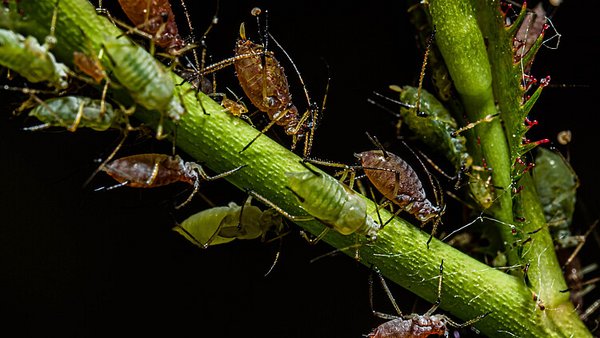- Share this article
- Subscribe to our newsletter
Effective protection against pests – many plants have resistance mechanisms
Whether it be greenhouse whiteflies, aphids or froghoppers, whenever plants defend themselves against pests, they often resort to similar methods. A study headed by Dr Daniel Leybourne, a postdoc at the Institute of Geobotany at Leibniz University Hannover (LUH)/Germany, shows that plants resistant to certain pest insects use similar defence strategies. This could be an aspect to set out from in breeding insect-resistant plant varieties. The results have now been published as an open-access manuscript in Scientific Reports.
Pest insects represent a major problem in agriculture all over the world since they cause damage to harvests and reduce yields. These negative impacts are expected to increase further in response to global warming, with forecasts indicating that with a temperature level increase of one degree, yield losses caused by insects could rise world-wide by ten per cent.
Pests already resistant through pesticide use
The pests are usually combated with pesticides. However, the latter harm both the environment and health, and furthermore, they contribute to a decline in beneficial insects. Widespread use of pesticides has also encouraged the development of pesticide-resistant insect populations, which makes crops even more vulnerable to becoming infested with pests.
However, some plants have developed special properties to defend themselves against insects. The resistance mechanisms of these so-called resistant plants could represent an alternative to combating pest insects with pesticides, according to Leybourne and co-author Dr Guðbjörg Inga Aradóttir, an entomologist at the United Kingdom’s National Institute of Agricultural Botany.
Thirty plant species analysed in 129 studies
The results of 129 surveys looking at how more than 30 plant species protect themselves against dozens of different insect species served them as a basis for their study. The team of researchers focused in particular on the physical, nutrition-physiological, chemical and molecular properties of plants contributing to their self-defence which could thus provide the basis for the development of pest-resistant varieties depending less on pesticides.
With their study, the scientists pursued the goal of finding out whether the resistance mechanisms applied by resistant plants are similar in different groups of plants and whether these resistance mechanisms are identical among various plant-insect combinations. Here, Leybourne and Aradóttir concentrated on the resistance mechanisms against sucking insects such as aphids, whiteflies and froghoppers, which belong to the most harmful insect groups that exist and for which extensive research results are available.
Plant sap-sucking insects use specialised mouthparts (stylets) to pierce vascular or other tissue and suck up the plant’s nutrient resources, which can directly damage the plant and facilitate the transmission of plant pathogens.
This meta-analysis revealed for the first time that many plant families apply the same resistance mechanisms against certain insect groups. For example, brassicascaceous plants and grasses resort to similar strategies to defend themselves against aphids.
The authors also found out that as a rule, insect-resistant plants demonstrate a higher content of certain organic chemicals as well as a higher density of hair-like structures (trichomes) on their leaves. These defence strategies seem to make it more difficult for insects to pierce the plant or probe into it and get to the plant sap, and as a rule, they are effective against many species of sucking insects.
These common features suggest that it could be possible to develop plant varieties with a broad resistance against insects. However, more detailed studies at the level of plant and insect species are needed to determine whether different insect species within one and the same family or group respond in a similar manner to the plant resistance mechanisms.
(uni-hannover/wi)
Reference:
Leybourne, D.J., Aradottir, G.I. Common resistance mechanisms are deployed by plants against sap-feeding herbivorous insects: insights from a meta-analysis and systematic review. Sci Rep 12, 17836 (2022). https://doi.org/10.1038/s41598-022-20741-3





Add a comment
Be the First to Comment